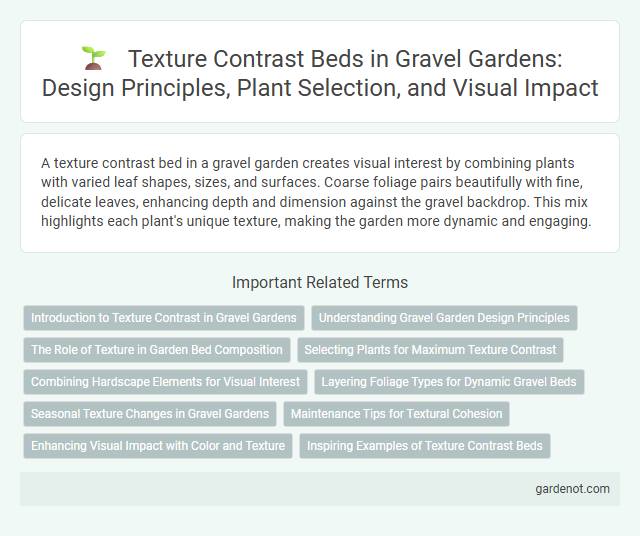A texture contrast bed in a gravel garden creates visual interest by combining plants with varied leaf shapes, sizes, and surfaces. Coarse foliage pairs beautifully with fine, delicate leaves, enhancing depth and dimension against the gravel backdrop. This mix highlights each plant's unique texture, making the garden more dynamic and engaging.
Introduction to Texture Contrast in Gravel Gardens
Texture contrast in gravel gardens enhances visual interest by pairing coarse gravel with fine-textured plants, creating dynamic interplay between hardscape and softscape elements. Combining rough stones with smooth, feathery foliage or spiky succulents accentuates tactile variation, supporting layered garden design. This approach improves depth perception and draws the eye, making gravel gardens more engaging and structurally balanced.
Understanding Gravel Garden Design Principles
Texture contrast beds in gravel garden design emphasize pairing coarse materials like larger stones or rough gravel with finer, smoother pebbles to create visual interest and depth. Understanding the balance between soft plant textures such as ornamental grasses and the hard, angular surfaces of gravel enhances the overall aesthetic and promotes a harmonious landscape. Strategic layering of textures contributes to both functional drainage and a dynamic sensory experience in gravel garden layouts.
The Role of Texture in Garden Bed Composition
Texture contrast in a gravel garden bed enhances visual interest by combining coarse gravel with smooth, broad-leafed plants that create dynamic sensory experiences. The interplay between rough, angular stones and soft, feathery foliage improves depth perception and highlights plant structures. Using diverse textural elements in bed composition emphasizes natural patterns and creates a balanced, captivating landscape design.
Selecting Plants for Maximum Texture Contrast
Selecting plants for maximum texture contrast in a gravel garden bed enhances visual interest and depth. Combine coarse-textured plants like ornamental grasses or yucca with fine-textured ground covers such as thyme or Santolina to create dynamic contrasts. Prioritize drought-tolerant, low-maintenance species that thrive in well-drained gravel environments for sustainable, year-round appeal.
Combining Hardscape Elements for Visual Interest
Combining hardscape elements such as gravel, stone pavers, and weathered timber in a gravel garden enhances texture contrast, creating a dynamic and visually engaging bed. The interplay between rough gravel surfaces and smooth or rugged stones emphasizes depth and variety, promoting a natural yet structured aesthetic. Strategic placement of these materials not only improves drainage but also directs movement and focal points within the garden space.
Layering Foliage Types for Dynamic Gravel Beds
Layering diverse foliage types creates striking texture contrast in gravel garden beds, enhancing visual depth and interest. Incorporating coarse, fine, and medium leaf shapes, such as ornamental grasses, succulents, and spiky evergreens, adds dynamic interplay against gravel mulch. This approach optimizes plant structure and color variation, promoting year-round appeal in drought-tolerant landscapes.
Seasonal Texture Changes in Gravel Gardens
Texture contrast beds in gravel gardens highlight seasonal texture changes by incorporating a diverse mix of plants with varying leaf shapes, sizes, and growth habits. Succulents, ornamental grasses, and deciduous perennials create dynamic visual interest as their textures shift from spiky and rigid in summer to soft and delicate in fall and winter. This layered approach enhances depth and dimension, making gravel gardens visually engaging year-round.
Maintenance Tips for Textural Cohesion
Maintaining a texture contrast bed in a gravel garden requires regular pruning to prevent overgrowth and preserve the distinct tactile qualities of each plant. Incorporate mulch and gravel strategically to enhance soil drainage and suppress weeds, promoting a clean and cohesive appearance. Regularly refresh gravel layers and remove debris to maintain sharp textural boundaries and garden harmony.
Enhancing Visual Impact with Color and Texture
Texture contrast beds in gravel gardens amplify visual impact by combining coarse gravel with soft, lush foliage and smooth, sculptural plants. Varying textures such as spiky grasses, velvety succulents, and rugged stones create dynamic layers that catch the eye and add depth. Incorporating vibrant colors like deep greens, silvery blues, and fiery reds alongside neutral gravel tones intensifies this contrast, making the garden visually striking.
Inspiring Examples of Texture Contrast Beds
Texture contrast beds in gravel gardens create dynamic visual interest by combining coarse gravel with soft, velvety foliage such as lamb's ear and fine grasses like blue fescue. Designers often pair rugged, angular stones with smooth-leaved succulents like hens and chicks to highlight tactile diversity. These inspiring examples demonstrate how layering diverse textures enhances garden depth and seasonal appeal.
Texture contrast bed Infographic

 gardenot.com
gardenot.com